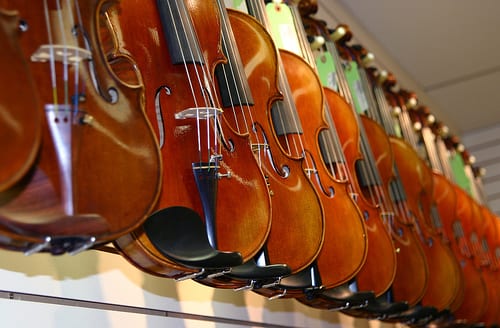When you’re learning how to play the violin, you may notice that the quality and type of strings you have can make a big difference on your tone and overall performance. But with so many types available, which is best for you? What are the best violin strings made of, and how do you select the right kind?
Just like guitar strings, violin strings can stretch and break for various reasons. Sometimes they snap when you’re tuning your instrument, while other times, they may fly off while you’re in the middle of playing a concerto. Aside from replacing old strings, you may find that you want to restring your violin with a different kind of string.
No matter where you are in your journey playing the violin, you’re eventually going to need to get new strings. Whether you’re asking yourself, “What type of violin strings should I buy?” or wondering what different violin strings are made of, we’re here to make sense of it all.
So first things first, what are violin strings made of? Typically, violin strings are made of three types of material: metal, gut, and synthetic materials. When it comes to determining the best violin strings, it really is a matter of preference and price range, as one kind of string isn’t exactly better than the next.
Are you going for a certain style or sound of music? Do you want a dark and warm sound or a bright and brilliant sound? And what kind of price range are you working with? You’ll come across several brands that specialize in each of these string types. What’s more, during your musical journey, you may find that you like experimenting with different styles of strings, or you prefer to stick with a tried-and-true kind of material that you know you like. Regardless, It’s a good idea to learn about the different types of violin strings and then make your decision accordingly.
(1) Metal Strings
Metal strings – also called steel core strings – are a very common choice for violinists, as they produce a bright, full sound when played with proper technique. When compared to gut strings, metal strings produce a more stable pitch, and they last longer. Folk and jazz musicians in particular, as well as electric violin players, usually favor metal strings because of their volume capacity and durability. Fiddlers, along with beginner and intermediate violinists, most often go this route when choosing the best violin strings for their instruments.
(2) Gut Strings
Historically, violin strings were created by using sheep intestines, sometimes wrapped with silver or copper wire. Although gut strings are not as prevalent today, some classical violinists still prefer this type because of their warm, complex tone. You will come across gut strings with different gauges, which can greatly affect the sound. For example, the thicker gut gauges will often sound more powerful and gritty than those with thinner gauges.
However, gut strings are very susceptible to changes in humidity, and weather in general, and therefore require more regular tuning, as well as time to settle and stretch out once they’re in place. They are also more expensive and don’t last as the other string types.
(3) Synthetic Strings
Synthetic strings made from high-tech nylon and other composite materials were introduced in the 1970s. Because of their quick response time to pressure, they are a great option for beginners. Synthetic strings offer the same warm tone found with gut strings, but don’t require as much upkeep, making them a great option for beginners. And like metal strings, synthetic strings maintain a more stable pitch than that of gut alternatives.
The best type of violin strings will depend on your playing level and needs, as well as the tonal qualities you prefer. Moreover, different violins may respond better to different string types. As with selecting a violin and finding the perfect violin bow, choosing the best violin strings can be a sometimes lengthy process that shouldn’t be neglected.
When comparing string types, keep in mind other factors that can affect the sound and tone, such as string gauge and string tension. If you’re looking for more advice on different types of violin strings, you may want to turn to a violin teacher. When you sign up for in-person or online violin lessons, you have the opportunity to meet with a private instructor dedicated entirely to you. You can ask all the questions you may have regarding what violin strings are made of and what the best options are for you and your music goals. Sign up for violin lessons today!
Like this post? Join the TakeLessons community and receive exclusive updates, expert advice, tips and more! Sign up for email updates here!
You might also like…
– Raising a Violin Virtuoso
– What the Heck is the Suzuki Method?
– Should Classical Violinists Learn to Improvise?
Photo by lemonjenny.
Suzy S.

